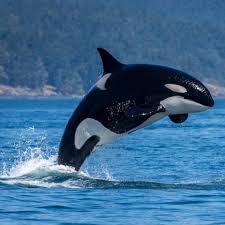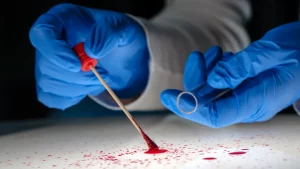Orcas, also known as killer whales, are the largest among the dolphin family. They are intelligent predators, feasting among marine mammals such as seals, sea lions, and even whales. With the assistance of razor sharp teeth and a superior intelligence, the orcas hunt in deadly pods. In family groups of up to forty, the whales use effective cooperative hunting techniques that model those of a wolf pack. Although they are fierce predators, the only danger these powerful creatures pose to humans seems to be when they are used for human entertainment and placed into captivity. In captivity, there have been over 100 incidents between human and whale, and a total of four deaths, while in the wild, no deaths have ever been recorded. Additionally, captivity causes damaging mental and physical effects on these magnificent creatures.1
On the morning of November 18, 1961, the first orca was captured in Newport Harbor, California. Millions watched as chaos consumed the harbor. Fishermen from Marineland of the Pacific scrambled to capture the distressed whale, and finally after many failed attempts, succeeded in capturing the animal. After being plucked from her natural home, Wanda was placed into a 100 by 50 by 19-foot oval tank. Immediately, she began to run into walls and swim restlessly in her new unnatural environment. Less than two days following her capture Wanda was found dead in her jail cell of a tank. Many biologists believe her death was a suicide. After reaching great speeds, she would strike her body against the walls until the last breath left her body and she was free from human confinement.2
This behavior of self-harm is not a natural behavior associated with orcas; however, it is very common among whales in captivity. Many captive orcas inflict pain upon themselves because they are bored and frustrated with their environment. One of the most common ways of inflicting self-harm is through dental destruction. Whales in captivity often chew on mental enclosures, causing extreme pain and damage to their teeth. Captive orcas often exhibit broken and worn teeth with exposed gums. This largely contrasts with orcas in the wild, who show little to no tooth wear.3
The extreme tooth damage leads to many other health issues that orcas in captivity regularly face. Due to the exposed gums, infectious diseases have a direct entry to the bloodstream and can reach vital organs such as the kidneys and heart. Heart disease and pneumonia are common diseases that are contracted via the tooth canals. Veterinarians routinely drill and work to combat these dental issues, yet little literature has been published by these medical experts on the topic. International researchers examined 29 captive orcas, all of which suffered from dental damage. They later learned that over 50% of them had undergone the painful modified pulpotomy procedure. This lack of veterinary transparency contradicts their claims that promote education and conservation for these wild animals.4
Another negative physical trend seen in captive orcas is the collapsed dorsal fins. Recreational parks such as Sea World depict orcas with healthy, natural looking dorsal fins; however, this is not a true representation of the orcas within the park walls. All captive adult male orcas suffer from collapsed dorsal fins, which is likely caused by the lack of space they have within their enclosures. It is said that less than 1 percent of orcas suffer from dorsal fin collapse in the wild. These statistics, looked at side by side, further the popular claim that captivity is detrimental to orcas.5

Being such social creatures, orcas travel in large groups called pods. They are acoustically oriented, using clicks, whistles, and echolocation to navigate their surroundings and communicate with one another. However, when in captivity there is no opportunity for them to take advantage of this natural behavior. Different whales from different pods use different types of clicks and sounds to communicate. Therefore, when whales from different parts of the world are thrown together in tanks, they are unable to communicate and often turn violent towards one another.6
The only recorded fatal attack by one orca on another occurred in captivity. Just as personalities clash, orcas can be incompatible with other orcas. Because orcas in confinement cannot choose their companions, we often see more dominant whales bullying the younger small whales in the enclosures. The lack of communication also adds to many of the issues among orcas in captivity. In severe cases, this dangerous behavior can lead to deep wounds and lacerations resulting in the animals having to be separated. This separation furthers the isolation these whales in captivity must face on a day to day basis. In the wild, aggression has been rarely observed, as the ocean is a huge habitat allowing the subordinate animal room to escape any aggression that may be present.7

However, the aggression exhibited by captive orcas is not only limited to other orcas, but to humans as well. While there have been no reported fatal attacks in the wild, hundreds of incidents have been recorded involving orcas in captivity. Perhaps the most famous incident was the death of veteran trainer Dawn Brancheau after being attacked by the infamous Tilikum. This incident showed that no matter the experience of trainers, these animals will always be in control. Former Sea World trainer Jeffrey Ventre explained how Tilikum “knew exactly what he was doing” when he killed the experienced trainer. Many trainers believed Tilikum’s troubled past is what led to his aggressive behavior.8
In 1983, near Iceland, 2-year-old Tilikum was torn away from his mother and ocean home. Taken to rundown marine park Sealand of the Pacific, Tilikum was forced into very unnatural conditions. Food was withheld from him and he often endured attacks from the two dominant females in the park. He was forced to perform eight shows a day, seven days a week. For Tilikum, being such a highly intelligent, emotional, and socially complex animal, captivity was devastating physically and mentally early on in his life. After much frustration, Tilikum acted out again, and killed trainer Keltie Byrne. In all, Tilikum was involved in the deaths of three different trainers. The staggering difference between the number of fatal attacks in the wild compared to those of this one whale show the dangerous effects captivity has on these ocean giants. Not only is captivity dangerous for these creatures, but also for those who are in charge of their so called well-being.9
Many often argue that whales in captivity are pivotal for research and breeding programs. However, the positives don’t outweigh the negatives when it comes to orcas and captivity. Whales in captivity are often impregnated at a young age. A Sea World orca was pregnant and gave birth at the young age of eight. There is also a lot of controversy surrounding Tilikum and his twenty-one offspring. Many believe, given his infamous violent behavior, that his genetics should not be passed down to other orcas intended for captivity and human entertainment.10
Orcas also are cared for by their mothers up until about two years. After this, they become part of the pod and travel with their native group. In a study of almost 600 orcas, data show that having a mom nearby significantly increased the survival rate of the calf. It was also found that female killer whales have strong motherly instincts and an urge to care for their young. In captivity, we often see calves being taken from their mothers at very young ages. This separation at such a young age can cause depression for the calves and mothers. John Hargrove, a former senior killer whale trainer at Sea World described his first-hand account of the separation of a mother and calf: “In fact, [when Takara was taken from Kasatka], she was emitting vocalizations that had never been heard before ever by anyone … obviously Takara was gone and [Kasatka] was trying anything she could to try to locate and communicate with Takara, which is absolutely heartbreaking.” 11 Hargrove alone can recall nineteen instances where a mother and a calf were separated. Seventeen were for management purposes while only two were for medical reasons. Separating a mother from her young is a traumatic experience that never happens in the wild.12

Leading orca researchers agree that captivity is devastating to these marine mammals, who in the wild, engage in tight knit relationships with one another, travel over 100 miles daily, and work in pods to hunt and find food suited for their large diets. Many orcas have been captured and forced into captivity, which has denied them the opportunity to engage in their natural genetic behaviors. The constant factors that push them to be everything that they’re not causes them stress, anxiety, and depression that is not seen in wild orcas. These unnatural feelings cause them to exhibit unnatural behaviors never seen in the wild, such as extreme tooth damage from gnawing on cages, floating lifelessly in pools, and in some cases extreme aggression towards other orcas and humans.13
The limited dangers orcas face in the wild are often brought on by human activities such as overfishing and boating accidents. However, despite these dangers, orcas in the wild live more purposeful and meaningful lives, where they are free to live life as it comes; on its most natural course.14
- “The Fate of Captive Orcas,” WDC, Whale and Dolphin Conservation. Accessed November 05, 2018. https://us.whales.org/wdc-in-action/fate-of-captive-orcas. ↵
- “The Fate of Captive Orcas,” WDC, Whale and Dolphin Conservation. Accessed November 05, 2018. https://us.whales.org/wdc-in-action/fate-of-captive-orcas. ↵
- Sam Lipman, “The Orca of Marineland Antibes.” Orca Aware, (1970), http://bdmlr-orcaaware.blogspot.com/2016/04/the-orca-of-marineland-antibes.html. ↵
- Emma Foster et al., “Adaptive Prolonged Postreproductive Life Span in Killer Whales,” American Association for the Advancement of Science, (2014), science.sciencemag.org/content/337/6100/1313. ↵
- Cara Meyers, “SeaWorld’s Lies Sink To New Low,” Digital Journal,(2014);1-3. http://www.digitaljournal.com/news/environment/seaworld-put-on-notice-by-orca-scientist/article/384814#ixzz32wcTf3Qh. ↵
- Andre Chwalibog, “Orcas are Social Mammals,” MedCrave, (2018); 22-24. https://medcraveonline.com/IJAWB/IJAWB-03-00101. ↵
- Andre Chalibog, “Orcas are Social Mammals,” MedCrave, (2018); 22-24. https://medcraveonline.com/IJAWB/IJAWB-03-00101. ↵
- Caitlyn Burford and Julie Kalil Schutten, “Internatural Activists and the ‘Blackfish Effect’: Contemplating Captive Orcas’ Protest Rhetoric through a Coherence Frame,” Frontiers (2016), www.frontiersin.org/articles/10.3389/fcomm.2016.00016/full. ↵
- Caitlyn Burford and Julie Kalil Schutten, “Internatural Activists and the ‘Blackfish Effect’: Contemplating Captive Orcas’ Protest Rhetoric through a Coherence Frame,” Frontiers (2016), www.frontiersin.org/articles/10.3389/fcomm.2016.00016/full. ↵
- Melissa Cronin, “5 Reasons Why SeaWorld’s Orca Breeding Program Is Seriously Bad News,” Thedodo (2014), https://www.thedodo.com/5-reasons-why-seaworlds-orca-b-531056663.html. ↵
- “Former Orca Trainer For SeaWorld Condemns Its Practices,” (2015), https://www.npr.org/2015/03/23/394730076/former-orca-trainer-for-seaworld-condemns-its-practices. ↵
- Melissa Cornin, “5 Reasons Why SeaWorld’s Orca Breeding Program Is Seriously Bad News,” Thedodo (2014), https://www.thedodo.com/5-reasons-why-seaworlds-orca-b-531056663.html. ↵
- Vanessa Williams, “Dying to Entertain You,” WDCS, (2001); 3-5. http://www.wdcs.org/submissions_bin/orcareport.pdf. ↵
- Vanessa Williams, “Dying to Entertain You,” WDCS, (2001); 3-5. http://www.wdcs.org/submissions_bin/orcareport.pdf. ↵



107 comments
Alicia Guzman
This article really hits home as a San Antonio resident because of Sea World especially as someone who has seen the documentary Blackfish as well. I will never forget when I was in high school and came to San Antonio for the first time as a field trip with my junior class. Looking it back, it makes me so sad that there are facilities like these that capture and holds these beautiful creatures in captivity solely as a means of profit. Animals have rights too.
Tyler Reynolds
This was a well researched and structured article. I would appreciate it if you could define scientific terms like pulpotomy procedure next time.
I found it interesting that whales from different pods and places around the world use different clicks and whistles to communicate.
Even with the information presented to me on this article I still refuse to change my mind of the subject of Orca captivity. I believe that the free-market will determine the demand for these whales and their treatment. As we have seen in recent years, public outcry has been strong enough for SeaWorld to put an end to such attractions.
Ruby Wynn
Before reading this article, I had no idea that orcas were dolphins. It is terrible that people would continue to force orcas to live in an environment that makes them hurt or kill themselves, and subject them to dental modifications, collapsed dorsal fins, and early separation of mother and calf. Research, breeding, and entertainment are not worth the effects that they have on these creatures. If someone cannot provide a big enough and interesting enough enclosure for a pod of orcas, they should not be keeping them in captivity.
Oscar Ortega
This article does a fine job of addressing the now infamous topic of captive orca whales. While there are some instances where the article has room for improvement, on both the technical and narrative sides, they are few and far between, and they do not detract from the detailed event accounts and data, which paint a vivid picture and accrue an overwhelming amount of evidence and support for the argument. While many of us are, by now, aware and likely supportive of the idea that orcas are intelligent animals who suffer greatly from being held in captivity, for those who are not, this article does a fantastic idea of showing just how dire the problem is.
Victoria Salazar
I believe that any wild animal held in captivity is tragic. I think safaris that are used to rehabilitate injured animals or protect endangered species are the only reasons a wild animal’s life should ever be interfered with by a human. I do not know what inclined humans to start capturing orcas in the first place, but it should be stopped. Some people think aquariums and zoos are a great learning opportunity for humans, but it is not fair to the majestic creatures that belong in the wild. Therefore, I loved the awareness that this article raises and totally agree with the stance it takes.
Matthew Swaykus
While very few animals are capable of suffering from human disorders such as PTSD or psychological trauma, we must remember the creatures that do. While most headlines discuss the examples left by Wanda and Tilikum, we never truly talk about the animals that didn’t end up as suicide victims or serial killers. Often times, we do not consider the internal affects captivity has on the orca’s personality and physical health. As an lowly college student seeking a meeger degree in Environmental Science, that is all I have to comment on this subject.
On a different, more blunt note, this article could have been written better. I must be frank; it was annoying to read. Throughout the piece, the author listed examples of the harm which afflicts everyone involved in the process of captivity and overly-repeated her claim that these ill affects “never happen in the wild”. Of course, the author only meant to emphasize her point and wasn’t aiming to sound bland. However, if you aren’t careful in your repetition of a statement that could be easily inferred, your audience may grow irritated.
Mia Morales
After watching the Black Fish documentary, I have been intrigued with orcas and their behaviors towards being held in captive. This article was well written and highlighted the issues that these harmless animals face. It is not normal for orcas to be held in such small containment. The situations where they have harmed humans are solely based on pant up aggression versus a natural aggression already in them. It is always heartbreaking to read about this issue, especially since many people are aware of it and Sea World still has not been shut down.
Maria Garcia
Orcas in captivity is something that I personally have always disagreed with because it’s inhumane. The article was very well written, and I liked how the details were given in a sort of chronological order. The orcas being held in tiny pools is just like putting a big family into a one bedroom home; it’s uncomfortable and aggravating. Orcas are big animals who need their space just like us humans do. The fact that Sea World is trying to promote their business by showing healthy Orcas, when they are all actually suffering in numerous ways, is disgusting because it is truly false advertisement. Although it was not stated in this article, I find it heartbreaking that Sea World’s parking lots are bigger than the Orcas tanks knowing how much space the animal really needs.
Tala Owens
I’m glad discussions like these are taken place a lot more recently. Tilikum showed what can happen to an ocra after it is kept in captivity for so long. Orcas aren’t made to be kept in small cages and only let out to entertain others. They are animals that belong in the ocean to swim around freely. Taken that freedom away from them is not only dangerous for them but trainers as well.
Averie Mendez
Reading about the first orca in captivity, Wanda, was particularly really sad to me because it proves the emotional distress captivity can have on animals. Yet we still have zoos, and amusement parks such as Sea World. It’s inhumane to force animals capable of such thought and emotion to perform shows everyday for human entertainment. To tear them from their habitat and confine them to cages is barbaric.